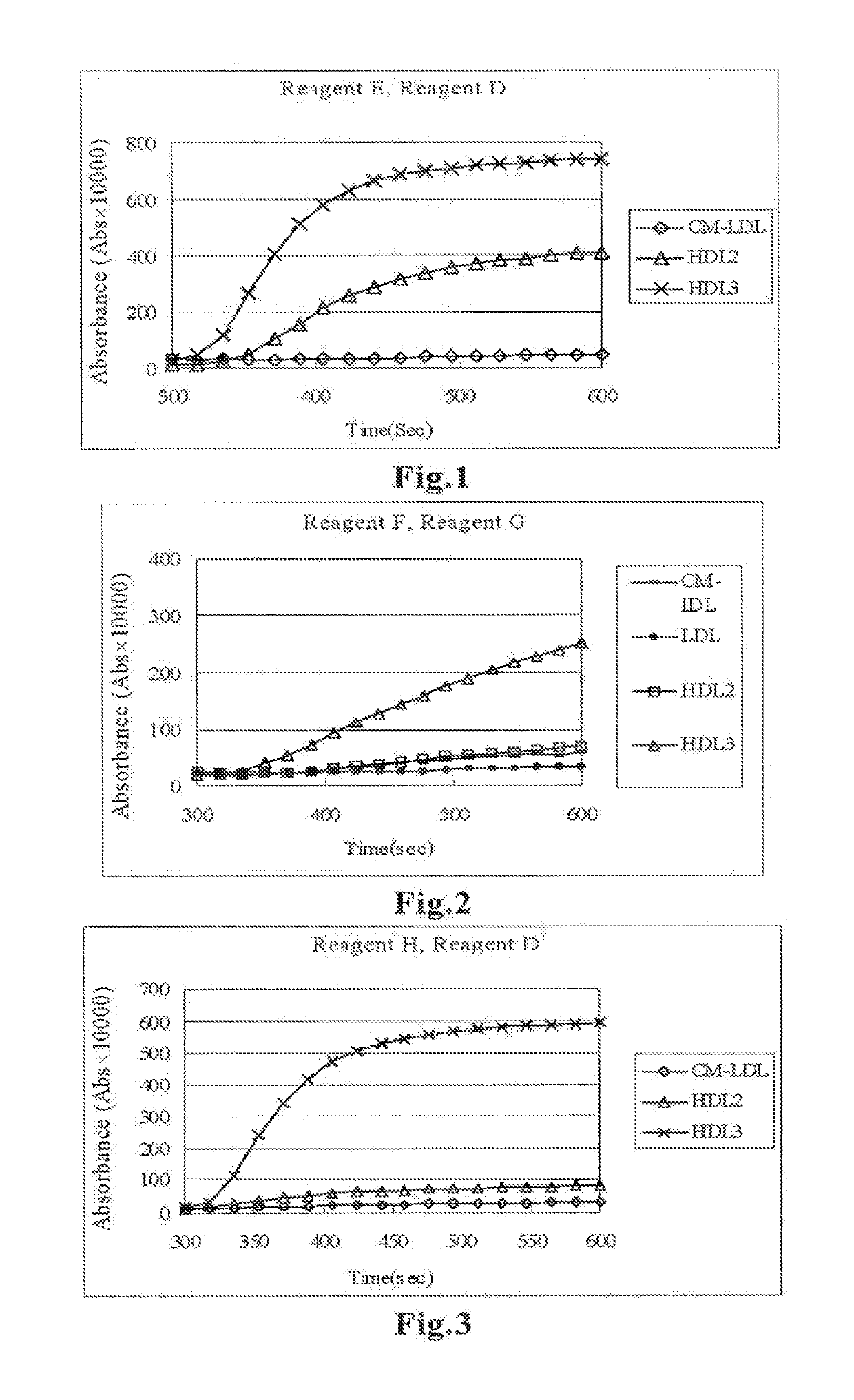Method for quantifying the amount of cholesterol in high-density lipoprotein 3
a high-density lipoprotein, cholesterol-based technology, applied in the direction of biochemistry apparatus and processes, instruments, material analysis, etc., can solve the problems of high cost, many days, and difficulty in operation
- Summary
- Abstract
- Description
- Claims
- Application Information
AI Technical Summary
Benefits of technology
Problems solved by technology
Method used
Image
Examples
reference example 1
[0054]Reagent A and Reagent B having the compositions described below were prepared, and reagents were prepared by adding various surfactants to Reagent A to a concentration of 0.1% (w / v) or 1.0% (w / v). Immediately before the measurement, Reagent A containing the various surfactants described below was mixed with Reagent B at a ratio of 1:3. Cholesterol in each of the HDL2 fraction and the HDL3 fraction was reacted with the resulting mixture, and the final absorbances at a main wavelength of 700 nm and a sub-wavelength of 600 nm were measured and compared.
[0055]Fractionation was carried out to obtain the HDL2 fraction and the HDL3 fraction as follows. A test sample containing HDL, that is, serum was subjected to ultracentrifugation using a solution with sodium chloride and sodium bromide such that separation occurs at a density at the border between HDL2 and HDL3 (1.125), and each resulting fraction was collected.
[0056]Table 1 below shows surfactants with which the ratio of HDL2 / HDL...
example 1
[0062]Fractionation by ultracentrifugation was carried out to obtain the CM-LDL fraction, HDL2 fraction and HDL3 fraction, and each fraction was reacted with Reagent E prepared by adding phospholipase D (PLDP) to Reagent A used in Reference Example 1. Reagent D described below was further added to the reaction solution to perform measurement. In the measurement, 150 μL of Reagent E was added to 2 μL of serum, and the reaction was allowed to proceed for 5 minutes with warming, followed by addition of Reagent D to the reaction solution and additional 5 minutes of reaction with warming. The absorbances at a main wavelength of 700 nm and a sub-wavelength of 600 nm were measured.
Reagent EBES buffer (pH 7.0)100mmol / LHDAOS0.7mmol / LCatalase600U / LCholesterol oxidase1.4U / mLCholesterol esterase0.8U / mLPhospholipase D5.0U / mL
Reagent DBES buffer (pH 6.6)100mmol / LSodium azide0.1%Emulgen B661.5%4-Aminoantipyrine4.0mmol / LPeroxidase2.4U / mL
[0063]FIG. 1 shows the result in terms of changes in the absorb...
example 2
[0064]Reagent F was prepared by adding a surfactant and sphingomyelinase to Reagent A used in Reference Example 1, and Reagent G was prepared for the step of measuring HDL3 in the product obtained by reaction with Reagent F. The compositions of these reagents were as shown below. Fractionation was carried out by ultracentrifugation to obtain the fraction from CM to IDL, LDL fraction, HDL2 fraction and HDL3 fraction, and the obtained fractions were subjected to measurement. The procedure for measurement with the reagents was the same as in Example 1. The absorbance was measured at each measurement time.
Reagent FBES buffer (pH 7.0)100mmol / LHDAOS0.7mmol / LPluronic F680.03w / v %Catalase600U / LCholesterol oxidase1.4U / mLCholesterol esterase0.8U / mLSphingomyelinase0.5U / mL
Reagent GBES buffer (pH 6.6)100mmol / LSodium azide0.1%Emulgen A902.0%4-Aminoantipyrine4.0mmol / LPeroxidase2.4U / mL
[0065]FIG. 2 shows the result in terms of changes in the absorbance with time of each fraction after addition of Re...
PUM
| Property | Measurement | Unit |
|---|---|---|
| density | aaaaa | aaaaa |
| density | aaaaa | aaaaa |
| reaction temperature | aaaaa | aaaaa |
Abstract
Description
Claims
Application Information
 Login to View More
Login to View More - R&D
- Intellectual Property
- Life Sciences
- Materials
- Tech Scout
- Unparalleled Data Quality
- Higher Quality Content
- 60% Fewer Hallucinations
Browse by: Latest US Patents, China's latest patents, Technical Efficacy Thesaurus, Application Domain, Technology Topic, Popular Technical Reports.
© 2025 PatSnap. All rights reserved.Legal|Privacy policy|Modern Slavery Act Transparency Statement|Sitemap|About US| Contact US: help@patsnap.com


